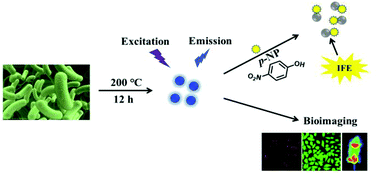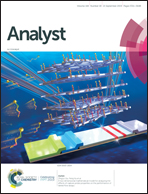Bacteria-derived fluorescent carbon dots for highly selective detection of p-nitrophenol and bioimaging†
Abstract
p-Nitrophenol (p-NP) pollutants are widely present in soil and aquatic environments and can seriously impair the health of living beings. Hence, a rapid, sensitive, and selective method for p-NP detection is urgently needed. Herein, for the first time, we successfully synthesized fluorescent carbon dots (CDs) from Bacillus cereus (BC) via a one-step hydrothermal process. The obtained CDs-BC can be applied as a rapid, highly selective, and sensitive sensor for p-NP detection. The fluorescence quenching efficiency of the CD-BC sensor exhibited excellent linear responses with p-NP concentrations at both 0.3–6.5 μM and 6.5–30 μM, with a detection limit of 0.11 μM. The mechanism of p-NP detection is based on the inner filter effect (IFE). Preliminary bacteria, cell, and animal studies showed that the as-prepared CDs-BC possess high photostability, excellent biocompatibility, low or no biotoxicity, and multicolor fluorescence emission properties; furthermore, they can be rapidly excreted from the body of mice, which suggests their potential for applications in the biomedical field.



 Please wait while we load your content...
Please wait while we load your content...